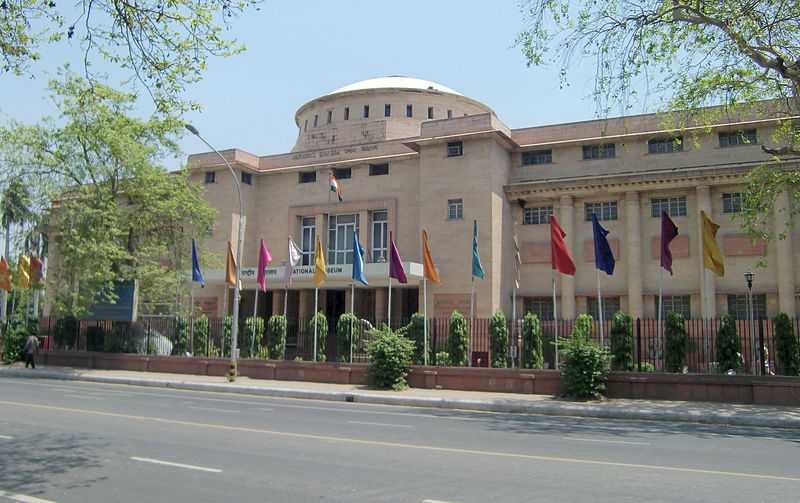
History of National Museum
In the winters of 1947-48, an exhibition on Indian arts and artefacts was set up in the Royal Academy of London. Post the event in London; the exhibition curators intended to display the entire collection in India before returning the antics to the respective individual museums. Therefore in 1949, an exhibition was organized in the premises of Rashtrapati Bhawan. The massive success of the exhibition led to the decision of the formation of a permanent National Museum. On 15th August 1949, the museum housed in Rashtrapati Bhawan was inaugurated by the then Governor- General of India- C. Rajagopalachari.
Later in 1955, the museum was moved to the current location and was formally inaugurated by the Prime Minister of India- Pandit Jawaharlal Nehru in 1960. Until 1957, the museum was run by Director General of Archaeology. Currently, it is maintained and managed by Ministry of Culture, Government of India.
Galleries in National Museum
The National Museum boasts of an extensive number of galleries possessing a sweeping number of exhibits and relics of ancient cultural heritage. Here?s mentioning a few of the several galleries present in the museum.
1.Harappan Galleryhouses various artefacts from the Indus Valley Civilization popularly called as Harappan or Indo- Saraswati Civilization. The prominent displays are the very famous figurine of the dancing girl and the priest's head. Most of these antics have been borrowed from the Archaeological Survey of India permanently. Apart from this, the gallery flaunts various terracotta sculptures, bone structures, ivory, semi-precious stones and numerous seals founded during excavations. The displays successfully contrast the glorious civilization of India at par with contemporary civilizations of Egypt, China and Mesopotamia.2. Spanning three dynasties, theMaurya, Shunga and Satvahana Art Galleryhas objects from the 4th century BC to 1st BC. The relics in this gallery showcase the Greek influence, which primarily include fragments of the railings and structures from ancient stupas. An important period in the religion of Buddhism, this gallery, however, just has depictions of Buddha?s life in the form of inscriptions or carvings without any real sculpture or physical form.3.Kushana Gallerydepicts objects from the Kushan Period ranging from 1st - 3rd century BC. This gallery primarily presents a demonstration of the Gandhara School of Art and Mathura School of Art. This is also the period when Buddha was shown in a physical form.4.Gupta Gallerydepicts the supreme Gupta period from 4th to the 6th century BC. The gallery is a celebration of marvellous sculpture and religious iconography with exhibits of Goddesses Ganga and Yamuna and magnificent sculptures of other gods and temples.5.Medieval Galleryis subdivided into Early and Late Medieval Artefacts. Early Medieval artefacts cover the Palas, Chalukyas and Pratiharas between 7th and 10th centuries, after the fall of Gupta Empire. Late Medieval artefacts have sculptures from the 10th and 13th centuries, of the Hoysalas, Gajapatis, Chauhans etc.6.Decorative Arts Galleryis a glimpse in the decorative articles across centuries which include collections of ivory, jade and ceramics, thrones of Indian rulers, Hindu and Jain pitakas, metalware, jewellery etc.7.Miniature Painting Gallerydisplays around 17000 paintings from all over India, extending over Mughal, Rajasthani, Deccani, Pahari and the others. The main theme of the paintings is Mahabharat, Ramayana, Purana, Ragamala, Baburname etc.8.Buddhist Art Sectionhouses the extensive relics, specimen and antics from the life and times of Buddha.
Auditorium in National Museum
In addition to the above, the museum also houses a compact but airy auditorium with a seating facility of 250 people.A brief film introducing the auditorium is screened several times in a day. Occasionally, the auditorium also screens film shows on art, history and heritage.
Audio Tour in National Museum
A 75-minutes audio tour can be facilitated at some extra cost, which is available in English, Hindi, French, German and Japanese.The cost for Hindi language (for Indians)- INR 100.The cost for other languages (for Indians)- INR 150.Cost for foreigners is included in the entry tickets.
Best time to visit National Museum
The perfect time to visit National Museum is early morning on Wednesdays, preferably around 10:00 AM as the museum conducts gallery talks every Wednesday at 11:00 AM in the respective galleries. Reach well in advance to get your tickets and proceed to your favourite gallery to attend the talk.
How to Reach National Museum
Delhi is a state well connected through metro and state-run buses. The nearest metro stations to the National Museum is Central Secretariat or the Udyog Bhavan Metro, both of which are situated on the yellow line. The museum is roughly around 3 - 4 kms from the metro; you can either hire a local or a battery run rickshaw. You can also book a taxi cab for a more comfortable journey. Alternatively, you can travel in one of the buses which will be relatively economical.
Top Tourist Places in New Delhi
Hauz Khas Village
Red Fort
Qutub Minar
India Gate
National Zoological Park
Chandni Chowk
All Tourist Places in New Delhi
Tips
1. Videography inside the premises is prohibited.2. Still Camera photography is allowed, but you need to take prior permission at the reception.3. Wheelchair facility is available for the handicapped. It is preferable to book beforehand.
Comments on National Museum
Post Your Comment